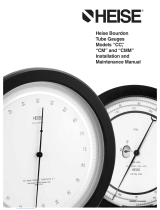
B400 Series standard – one 3
⁄
4˝ NPT conduit hole right side.
B700 Series standard – two 3
⁄
4˝ N PT conduit holes with one
permanent plug. NEMA 7 & 9 enclosures require proper conduit
seals and breathers as per the National Electrical Code.
B400 & B700 Series – XJL variation – two 3
⁄
4˝ NPT conduit
holes with two 3
⁄
4˝ to 1
⁄
2˝ NPT reducing bushings.
B400 Series – XJK variation – two 3
⁄
4˝ NPT conduit holes.
B400 SERIES
SPDT – Wire directly to the switch according to circuit require-
ments. On controls with pilot lights wire lights according to cir-
cuit diagram on inside of cover. See special wiring instruction
tag for single switches with two pilot lights and dual switches
with one or more lights.
2 SPDT – Dual switching elements consist of two SPDT switch-
es mounted together in a bracket. Switches are calibrated to
have simultaneous operation within 1% of range either on
increasing or decreasing pressure but not in both directions.
Wire directly to the front and rear switch according to circuit
requirements. Leads are provided on rear switch color coded as
follows:
Common – White
Normally Closed – Red
Normally Open – Blue
See SPDT instructions for pilot light hook-up.
When hermetically sealed switch elements(s) are supplied, the
lead color coding is as follows:
Common – White
Normally Closed – Red
Normally Open – Blue
B700 SERIES
SPDT – Wire directly to the switch according to circuit require-
ments.
2 SPDT – Wire to front switch terminal block (left) and rear
switch terminal block (right) as marked. Strip insulation 5
⁄
16˝,
insert in proper terminal connector and tighten clamping screw
to secure.
ADJUSTMENT OF SETPOINT
B400 & B700 Series – A single setpoint adjustment nut (7
⁄
8˝) is
located centrally at the bottom on the inside of the enclosure.
For accurate setpoint calibration, mount the switch on a cali-
bration stand, a pump or catalog No.1305 deadweight gauge
tester. A suitable reference standard such as an Ashcroft
Duragauge or Test Gauge is necessary to observe convenient
changes in pressure.
As received, the pressure switch will normally be set to
approximately 90% of the indicated range. Pressurize the
system to required setpoint and turn the adjustment nut until
switch changes mode. Direction of turning is indicated on a
label affixed to the inside of the control enclosure. When set-
point has been achieved raise and lower pressure to insure that
setpoint is correct.
SETPOINT LOCKING SCREW (B400 ONLY)
Once setpoint has been determined, tighten setpoint locking
screw using a 5/64˝ allen (hex) wrench. Do not over torque;
setpoint locking screw only needs to be hand tight.
When performing calibration or changing the setpoint, the setpoint
locking screw should be loosened before turning the setpoint
adjusting nut. Once calibration is complete, re-tighten the set-
point locking screw.
After installation of the control replace cover to insure electrical
safety and to protect internal parts from the environment.
B450 and B750 VARIABLE DEADBAND SWITCHES
Deadband is varied by rotating the wheel on the precision
switch. When viewed from the front of the enclosure, rotation to
the left increases deadband – rotation to the right decreases
deadband. Letters on the wheel may be used as a reference.
Deadbands obtainable will vary from 0.5% to 9% of pressure
range depending on range segment and type of diaphragm.
ADJUSTMENT OF SETPOINT
As received, the pressure switch will normally be set to approxi-
mately 90% of range. Rotate the wheel on the MICRO SWITCH
all the way to the right; this will provide smallest deadband.
Pressurize the system to the required setpoint and turn the
adjustment nut until the switch changes mode. Lower the
pressure to reset the switch. Rotate the wheel on the MICRO
SWITCH until the desired deadband is obtained. The upper
setpoint will be changing upward with this adjustment. Lower
the pressure to reset the switch. Then increase the pressure to
the desired setpoint and turn the adjusting nut until the switch
changes mode. Lower the pressure and check resetpoint and
deadband.
Note – As indicated above, adjustment of setpoint is made by
use of 7
⁄
8˝ nut. Precision switch element mounting
screws and bracket adjusting screw are factory sealed
and should not be tampered with.
Note – Since vacuum models are already above setpoint at
atmosphere, the Normally Open (NO) circuit will be
closed as received.
Recommended Practices
Ashcroft recommends regular inspection of the operation and
setpoint of the switch in critical applications to prevent issues
that could cause severe damage to personnel or property.
Installation and Maintenance Instructions for
B400 & B700 ASHCROFT®Snap Action
Switches for Pressure Control
TERMINAL BLOCK
SWITCH A
TERMINAL BLOCK
SWITCH B
2
1
3
2
1
3
NC
NO
C
NC
NO
C
© 2015 Ashcroft Inc., 250 East Main Street, Stratford, CT 06614-5145, USA, Tel: 203-378-8281, Fax: 203-385-0499, www.ashcroft.com
All sales subject to standard terms and conditions of sale. I&M009-10008-10/00 (250-2246E) 06/15
Setpoint
Locking
Screw




